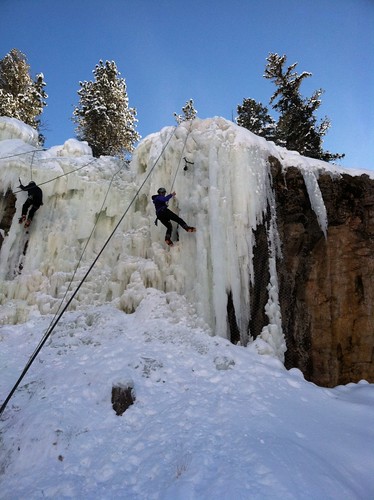|
Where on your finger is it? Is it tender to the touch, or does it just hurt to make a fist? It's very likely you have an overuse injury, which will heal quickly as long as you don't aggravate it. Take 4-5 days off, and in the meantime, go get some power puddy or a squeeze ball and do that all day every day. These injuries heal slowly due to lack of blood flow, and if you can keep the blood flowing in your hand, they'll heal exponentially quicker. I find running warm water over the hand to help as well. After 4-5 days, Start back in slowly, but not too slowly. Some pain is okay and expected one you start back up, but you should notice that it gets generally better each day, and that the pain is largely present on the ground, not while actually climbing. I've lived by this article whenever I get injured, and it's served me well (for reference, I climb up to 5-6 times a week and I've never had to take more than a week or so off for injury purposes): http://www.dizzy-heights.co.uk/tendons.html And in my opinion, tape doesn't really do anything for these types of injuries. I really only use tape for shredded skin and such. Others will disagree, though.
|
|
|
|

|
| # ? Apr 20, 2024 00:02 |
|
Tarnien posted:Where on your finger is it? Is it tender to the touch, or does it just hurt to make a fist? It's very likely you have an overuse injury, which will heal quickly as long as you don't aggravate it. Take 4-5 days off, and in the meantime, go get some power puddy or a squeeze ball and do that all day every day. These injuries heal slowly due to lack of blood flow, and if you can keep the blood flowing in your hand, they'll heal exponentially quicker. I find running warm water over the hand to help as well. After 4-5 days, Start back in slowly, but not too slowly. Some pain is okay and expected one you start back up, but you should notice that it gets generally better each day, and that the pain is largely present on the ground, not while actually climbing. I'm not completely sure where in the finger is. Seems like it is around the second joint. I'm having a hard time locating exactly where though. It is not tender to the touch, it's just when I make a fist. Thanks for all the tips, I'm gonna try using my strength grip donut (or does that put too much strain on the fingers?) and just wait a couple of days. That link was awesome by the way.
|
|
|
|
Climbing through finger pain is really never a good idea, unless you are completely knowledgeable about what is happening to the exact tendon in your finger causing you pain and can formulate some recovery plan. Overuse injuries from climbing usually happen slowly and cause soreness that recovers less and less over time. If it was bad enough to where you had to stop mid session and now hurts to make a fist, you definitely need to take time off. I would suggest a lot longer than 4 or 5 days. Tendons are sketchy because they take a lot longer to heal than muscles and are more prone to permanent damage, and remember there's no muscles in your fingers. I would climb very often until the soreness would get bad, and then ease off for a bit until the pain went away. Rinse and repeat a dozen times over the course of a year, and now I haven't been able to climb in 6 months because the middle finger on my right hand get's aggravated when I climb now.
|
|
|
|
And this is where the 2 schools of thought regarding climbing injuries come in. Climbing through the pain is never a good idea at first, but if it's not a serious injury (ie, you didn't feel a pop or aren't severely handicapped when it comes to normal daily activities), then I personally believe that any more than a week off isn't going to do you any good. It's the same theory that doctors used to apply to back and shoulder injuries -- people were instructed to avoid stressful activity after an injury for as long as it took to feel "better," but it turned out that this simply prolonged the injuries and slowed recovery. Nowadays, back and shoulder injuries are pushed into rehab as soon as possible, with better outcomes. Time is a necessary component, but bloodflow is what ultimately leads to full recovery, and you're not going to get bloodflow without using the muscles/tendons. Feel free to ignore me, and conversely don't get angry if my approach doesn't work for you, but like I said it's worked for me through multiple injuries. Do some research yourself and try various things out. Everyone's body is different and heals differently, so what works for me may not work for you. But I would stress that you should NOT just sit idly by for 6 months and hope an injury heals on its own. It absolutely will not heal completely until you stress it. My very first injury took 8 months to heal because I was so afraid to climb on it that I'd back away at the slightest discomfort. I saw a doctor who said that the pain was likely scar tissue, and told me to stress my fingers and climb through it. After doing that, the issue resolved itself within a week or two. Since then, I've been a huge fan of active recovery rather than passive recovery. Edit: Also want to emphasize that I'm not saying climb at 100% effort immediately upon returning. Obviously it's a gradual buildup, but some pain is not necessarily a bad thing. Tarnien fucked around with this message at 03:55 on Jan 22, 2014 |
|
|
|
You know how to avoid the build-up of scar tissue? I'm willing to bet most people who've had pulley injuries have tried the "just climb through it" method, because that's a lot easier than not climbing. In my experience with multiple pulley injuries, none of them serious enough to feel a pop or affect daily activities, that's a terrible approach to take (at different points I've had to take anywhere from 3-6 months off when minor discomfort turned into habitual discomfort turned into chronic pain). There are tons of ways to get blood flowing that aren't nearly as risky or tempting in terms of overuse as just climbing through pain. E: Like if you have a rotator cuff injury, the rehab isn't to just go out there and throw lightly. It's targeted, controlled exercises to rebuild the area around the injury, and only after months of that are you back to being able to pitch at all. Even if you're climbing stuff completely in your wheelhouse, fatigue or a random foot slip can easily lead to putting much more strain on the finger than intended and setback all of your rehab progress. Papercut fucked around with this message at 05:26 on Jan 22, 2014 |
|
|
|
Yeah that's exactly what happened to me. I was climbing lightly with some mild discomfort in an attempt to keep things warm rather than be idle while recovering, and then my foot slipped on a small hold. I'd say do whatever works I guess, but there's a reason tons of climbers fear tendon injuries. Regardless of your preferred type of recovery, prevention is still best. If pain is causing you to bail mid session, its time to slow down or take a nice break.
|
|
|
|
any colour you like posted:I've been bouldering and climbing harder than usually lately (harder grades, not more often), but yesterday I had stop climbing because of a pain in my middle and ring finger on my right hand. I was hoping the pain would go away after a night of sleep, but the fingers are still numb and it's a litte painful to clench my hand to a fist. Should I take a break from climbing until the pain goes away, or is it ok to just tape the finger when I go climbing? I've had a lot of advances in techinque and strength lately so it would suck if I have to stop climbing for a while. Stop climbing at least until you don't notice any pain during daily activities (maybe a week or two?). The improvements you made in technique are permanent and if you happen to lose a little strength while resting, it will come back quickly. It's tempting to keep climbing when you've just made improvements, but it's not worth risking a serious and nagging injury for the rest of your climbing career. The rock will still be there in a week or two.
|
|
|
|
any colour you like posted:but the fingers are still numb Thats not normal at all from my experience. I was be considering going to a doctor is anything goes numb like that and doesnt clear up almost straight away.
|
|
|
|
Tarnien posted:And this is where the 2 schools of thought regarding climbing injuries come in. Climbing through the pain is never a good idea at first, but if it's not a serious injury (ie, you didn't feel a pop or aren't severely handicapped when it comes to normal daily activities), then I personally believe that any more than a week off isn't going to do you any good. It's the same theory that doctors used to apply to back and shoulder injuries -- people were instructed to avoid stressful activity after an injury for as long as it took to feel "better," but it turned out that this simply prolonged the injuries and slowed recovery. Nowadays, back and shoulder injuries are pushed into rehab as soon as possible, with better outcomes. Time is a necessary component, but bloodflow is what ultimately leads to full recovery, and you're not going to get bloodflow without using the muscles/tendons. I took off more than a year waiting for a finger tendon injury to heal. I've only had success with time off (I usually do more than 1 week, like 2-3, but apparently shorter works for Tarnien, I've not really tried shorter) followed by a slow return to climbing. I usually climb 3 days a week, so what I'll do is go back and day 1 is 10a and easier. Day 2 is 10b, Day3 is 10c, etc until I get up to 12a which is about where I top out. During the return I take the time to work on using an open grip, and avoid shock loading my fingers, and there should be little to no pain. This approach hasn't worked as well with my elbows, so I'm still figuring those out. Also climbing outside is a good way to recover, since climbing below your max outside is way more fun than doing it inside. Learning to trad climb was my recovery plan one year as well.
|
|
|
|
modig posted:This approach hasn't worked as well with my elbows, so I'm still figuring those out. Also climbing outside is a good way to recover, since climbing below your max outside is way more fun than doing it inside. Learning to trad climb was my recovery plan one year as well. Rehab exercises, taping it, Voltaren gel and avoid max strength overhanging moves for a while seem to have cured my chronic bicep tendinitis. I believe the biggest contributors have been the rubber band exercises. Haven't felt any pain or the need to tape for two weeks now. Guess I should also start lifting weights to occasionally work the antagonist muscles as well.
|
|
|
|
Any boulder goons climbing indoors tonight? I was thinking of hitting The Spot later tonight for a business casual session and then try my hand at the beastmaker app. 
|
|
|
|
Sigmund Fraud posted:Rehab exercises, taping it, Voltaren gel and avoid max strength overhanging moves for a while seem to have cured my chronic bicep tendinitis. I believe the biggest contributors have been the rubber band exercises. Haven't felt any pain or the need to tape for two weeks now. Guess I should also start lifting weights to occasionally work the antagonist muscles as well. I've been doing some "wrist eccentric" exercises with weights, and taking time off. What rubber band exercises are you doing? There is a youtube channel from 919 clinic is climber injury focused that I've been looking at: https://www.youtube.com/watch?v=-HkjuR42vzk
|
|
|
|
gamera009 posted:Any boulder goons climbing indoors tonight? I was thinking of hitting The Spot later tonight for a business casual session and then try my hand at the beastmaker app. Not tonight. Maybe I'll get up to Boulder on the weekend.
|
|
|
|
So I'm a 200lb guy (14%bf, like decently strong) who is having a lot of trouble progressing from v0-v2 to v3/v4s and it seems to me to be just straight up forearm strength (and it doesn't help that I only climb at the end of my normal lifting routine). At what point can I expect my grip strength to finally catch up with my weight? At what weight would I be able to climb more efficiently at? I understand technique is a wholly different affair, but I've never met anyone who climbs at my weight and have no idea how bigger climbers are supposed to progress.
|
|
|
|
Finally managed my first 5.12 on lead. Indoors, but this felt much much harder than anything I'd ever done outside, so I'll buy it. Absolutely wiped after the effort.
|
|
|
|
Eat Bum Zen posted:So I'm a 200lb guy (14%bf, like decently strong) who is having a lot of trouble progressing from v0-v2 to v3/v4s and it seems to me to be just straight up forearm strength (and it doesn't help that I only climb at the end of my normal lifting routine). At what point can I expect my grip strength to finally catch up with my weight? At what weight would I be able to climb more efficiently at? How tall are you? V3 is basically every climbers first major plateau, if you read through the last few pages you see several people asking the same question. Climbing is grip intense, and therefore forearm intensive, so if you are climbing after a lifting routine you are probably going to fatigue quickly. That said, there's almost a 100% chance that your problem is technique and has very little to do with grip. Bigger guys, especially bigger guys who are decently strong, over-utilize upper body when climbing. This problem is evident when you start encountering routes/holds that cannot support your full weight with just your hands (v3 and up generally). Your grip strength will continue to increase from climbing for years, and the lighter you are, the more efficiently you can climb. There's really no special ratio.
|
|
|
|
gamera009 posted:Finally managed my first 5.12 on lead. Indoors, but this felt much much harder than anything I'd ever done outside, so I'll buy it. Absolutely wiped after the effort. Nice job!
|
|
|
|
gamera009 posted:Finally managed my first 5.12 on lead. Indoors, but this felt much much harder than anything I'd ever done outside, so I'll buy it. Absolutely wiped after the effort. Way to go dude!
|
|
|
|
Eat Bum Zen posted:So I'm a 200lb guy (14%bf, like decently strong) who is having a lot of trouble progressing from v0-v2 to v3/v4s and it seems to me to be just straight up forearm strength (and it doesn't help that I only climb at the end of my normal lifting routine). At what point can I expect my grip strength to finally catch up with my weight? At what weight would I be able to climb more efficiently at? Try doing circuits on a bunch of overhung problems or doing some hangboard sloper/jug exercises. But to echo Baldbeard it's almost 100% your technique.
|
|
|
|
Baldbeard posted:How tall are you? V3 is basically every climbers first major plateau, if you read through the last few pages you see several people asking the same question. Climbing is grip intense, and therefore forearm intensive, so if you are climbing after a lifting routine you are probably going to fatigue quickly. That said, there's almost a 100% chance that your problem is technique and has very little to do with grip. Bigger guys, especially bigger guys who are decently strong, over-utilize upper body when climbing. This problem is evident when you start encountering routes/holds that cannot support your full weight with just your hands (v3 and up generally). I'm 5'10". Currently trying to cut to 190 or 180 even if I lose a lot of muscle. Okay, while I'm sort of v-shaped I've managed to balance out my muscle so my max bench is 315 and max dl is 450. I'm trying to improve leg/posterior chain strength but it isn't transferring over as well as I'd thought, potentially because I'm always gassed when I climb. One technique I'm working on is just doing v2s and v1s I already know how to do, but doing them with 'quiet feet'. Like, trying to be as light as possible and planting my toe on a foothold instead of flat-footing it to gain maximum mobility. Other climbers tell me it should just be second nature by the time I'm getting good. Are there other specific ways I can improve my technique even if I'm already in a fatigued (post-lifting) state? e: and finally what cool core routines do you guys do? I kind of cycle through them and I know I could google climber core but I've gotten bored with the one I currently do. Eat Bum Zen fucked around with this message at 20:13 on Feb 2, 2014 |
|
|
|
Tons of body weight exercises for me, personally. Hanging leg lifts of all variations, front levers (drop set them by tucking 1 leg up or having someone hold your feet), and traversing 45 degree walls or steeper.
|
|
|
|
Eat Bum Zen posted:
Technique will come with more time on the wall, and the more energy you save for climbing the more you will get out of it. The downside to having your physical strength surpass your technique is that it tricks you into thinking you need more power, more grip, and more energy to get passed a plateau. I remember watching an episode of Fear Factor where a body builder dude couldn't even swing through some suspended monkey bars because he tried to do it totally stiff with his whole body flexed. Meanwhile the next contestant, a ~115lb woman gracefully swung across with her arms straight and locked, using her legs and core to generating momentum and swing. It's ridiculous how well that relates to climbing. One of the best ways (other than climbing) to improve technique is just to watch other climbers who are better than you. You should notice that they are twisting at the hips and knees, and doing lots of lunging motions rather than simply pulling themselves upwards with their arms. As for cool core exercises, just go with what pokchu said. Hanging leg lifts are my absolute favorite. Hang from a bar with your arms straight and envision a foothold somewhere off in an awkward direction -- try to put a foot there by moving your core around. Then do it again with your arms locked at a 45 degree angle. Then do it again with your arms locked closed in a full pullup or chinup position. etc... When you get to V4-V5-V6, there's so many moves where you are just stabilizing yourself with your arms/hands and just...trying...to...reach with a drat toe.
|
|
|
|
No joke, especially on steep problems and routes you'll find yourself having to cut feet and get to a new foot as soon and as stable as possible. It's your core that makes that work.
|
|
|
|
First time out ice climbing today. IMG_3567 by WestslopeBruin, on Flickr As you can see, I am very capable and graceful.
|
|
|
|
Get you heels down. Going up on your toes like that will cause your crampons to pop out of the ice.
|
|
|
|
Yeah, I discovered that. You know, after I retrieved my ice tool and mitten.
|
|
|
|
Hurray! I got my first real climbing injury!  I was attempting a problem that I've already completed before but was trying it in a slightly different way and felt something in my wrist kind of 'pop'. Now I can't make a fist without my ring finger hurting. I was attempting a problem that I've already completed before but was trying it in a slightly different way and felt something in my wrist kind of 'pop'. Now I can't make a fist without my ring finger hurting.Is this the kind of thing that will heal itself after a couple of weeks rest or will I need to go see a doctor? Of course this would happen on literally the same day that I signed up for a 12 months membership of my climbing gym.
|
|
|
|
Headhunter posted:Hurray! I got my first real climbing injury! If you felt a pop and have pain, you should go see a doctor.
|
|
|
|
So last night I visited a bouldering specific gym rather than my usual "top-rope with a bouldering wall" place, after taking a year off from climbing, and drat but it kicked my rear end. At the old place I could crank out up to a V2 on a good day despite the vacation, but at this new one it was like the V0's were climbing ladders and the V1's all required jump-grabs to crimps with a hand reversal in the process. Do I just suck?
|
|
|
|
Either you suck, not reading the routes right, or the setters are terrible (which is super possible, lots of good climbers think they can set routes and set everything super hard or super confusing thinking it is easy).
|
|
|
|
If you took a year off from climbing, don't expect to be as strong when you come back. Climbing strength fades (and returns, thankfully) very quickly. Also, some gyms are just genuinely bad at setting. If the movement doesn't appeal to you, go elsewhere. Nothing worse than climbing on bad setting (gyms that use footholds as hands, or make climbs hard by simply turning a good hold upside down are personal peeves of mine). And to the guy who felt a pop in his wrist -- go see a doctor. Sooner rather than later, as it might impact your ability to use the hand in the future. Tarnien fucked around with this message at 20:25 on Feb 5, 2014 |
|
|
|
Tarnien posted:(gyms that use footholds as hands, or make climbs hard by simply turning a good hold upside down are personal peeves of mine). Wait, so on some of the paths that I have seen at my gym, you are supposed to use a foothold as both a handhold and a foothold. Does that mean I'm reading the route wrong??? Also, my gym has been closed for almost 4 months because the NYC Department of Building found minor discrepancies between their floor plan and what was actually built (stupid stuff like a lightswitch wasn't in the same place as the sketch). It really sucks because my gym closed right when I was starting to *get* bouldering, and now I've probably lost all the strength/skills that I was building up. 
|
|
|
|
4R7 THi3F posted:Wait, so on some of the paths that I have seen at my gym, you are supposed to use a foothold as both a handhold and a foothold. Does that mean I'm reading the route wrong??? You can do whatever you want...I've never seen a route set that literally prohibits using certain holds for hands/feet/etc. But there will be an advantage to using holds as intended by the setter.
|
|
|
|
Many routes have you climb up to a hold, then later stand on that same hold or knee bar it, or heel hook it. Also, don't forget smearing -- many, many times you will need to place a foot on a random spot on a wall to anchor yourself, or provide just a little bit of friction. You don't have to play 'the wall is lava' on any route ever. I think the biggest mistake climbers in the V0-V2 zone make is feeling bound to always have their feet on footholds. Flagging is by far the most usefull technique to improve climbing, and its really hard to teach and practice for some reason. Probably because the idea of using your foot as a weight rather than to hold weight seems counterproductive.
|
|
|
|
4R7 THi3F posted:Wait, so on some of the paths that I have seen at my gym, you are supposed to use a foothold as both a handhold and a foothold. Does that mean I'm reading the route wrong??? Is this Cliffs? I thought it closed because they didn't actually have building permits for the work and opened without getting a building inspection?
|
|
|
|
4R7 THi3F posted:Wait, so on some of the paths that I have seen at my gym, you are supposed to use a foothold as both a handhold and a foothold. Does that mean I'm reading the route wrong??? No, you're doing it fine. And again, do whatever works to get to the top. I'm talking about gyms that use ONLY footholds on a climb in an effort to make the climb "hard," rather than using difficult movement/unique positions.
|
|
|
|
Super excited to be involved In a setting clinic with Timy Fairfield at the end if this month.
|
|
|
|
re: footholds as hands H's referring to the specific type of hold, i.e. little foot jibs, which are sometimes used by setters in a route to simulate a lovely crimp or whatever. These routes generally aren't anywhere near as fun as an equally difficult problem that instead earns its rating by rewarding good technique. All of my favorite climbs have been ones that utilize creative body positioning or have some quality to them beyond "make the holds shittier or further apart so it's harder."
|
|
|
|
Teeter posted:re: footholds as hands Ah yeah, I see that now. Yeah, some setters use foot chips as some kind of make-shift crimp. Usually just makes the route more confusing.
|
|
|
|

|
| # ? Apr 20, 2024 00:02 |
|
jackchaos posted:Super excited to be involved In a setting clinic with Timy Fairfield at the end if this month. Are you an Albuquerque local? Not often I find Albuquerque goons, let alone those that climb.
|
|
|





















